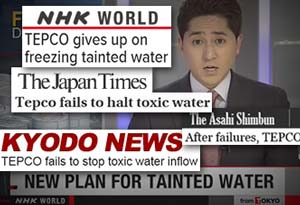http://www.asyura2.com/14/test30/msg/753.html
| Tweet |

Officials have “admitted failure” at Fukushima plant — Giving up on attempts “to prevent highly contaminated water from pouring into ocean” — Regulator asks “What was all the trouble over the past months for?” — Gov’t experts worried cement barrier is going to crack (VIDEO)
(東電)当局は、福島原発での「失敗を認めた」−「海に注ぐ高度汚染水を防ぐ試みをあきらめる−規制委員は「過去数ヶ月間にわたるすべての苦しみは、(一体)何のためだったか?」と尋ねる−政府専門家は、セメントバリアが割れることを心配している(映像)
Published: November 23rd, 2014 at 1:35 pm ET By ENENews
公開:2014年11月23日、午後1:35 ET ENENewsによる

Japan Times, Nov 22, 2014 (emphasis added): Tepco fails to halt toxic water inflow at Fukushima… [TEPCO] admitted failure Friday in its bid to halt the flow of toxic water into underground tunnels alongside the ocean… Some 11,000 tons of highly radioactive water have accumulated in the tunnels… connected to the reactor 2 and 3 turbine buildings… according to Tepco. There are fears that this toxic buildup… could pour into the Pacific, which is already being polluted by other radioactive leaks… Friday, Tepco proposed a new technique for the tunnels: injection of a cement filler… some [highly radioactive water] would be left behind, endangering plant workers, Tepco acknowledged… [Gov't experts] argued that Tepco should stick to the original plan and draw out all of the water. Others said giving up on it may hamper the construction of the ice wall.
ジャパンタイムズ、2014年11月22日(強調は記者):東京電力は、福島での有毒水の流入を停止することができない... [東京電力]金曜日に、海のそばの地下トンネルへの毒性水の流れを停止する、その骨折り(苦労)の失敗を認めた ... 11000トンの高レベル放射性(汚染)水は、トンネル内に蓄積してきた...東京電力によれば...2号原子炉と3号原子炉のタービン建屋に接続されている。 この有毒な蓄積は...太平洋に注ぎ得るという恐れがある、そして太平洋は既に他の放射性漏洩によって汚染されている...金曜日、東京電力はトンネルに対し新しい手法を提案した:セメント充填剤の注入...いくらかの[高放射性(汚染)水]は、取り残されるであろう、そして原発作業員を危険にさらす、と東京電力は認めた...[政府の専門家は] 東京電力は当初の計画に固執して、全ての水を引き揚げるべきだと主張した。他(の専門家)は、それをあきらめることは凍土壁の建設を妨げるかもしれない、と言った 。
Mainichi Daily News, Nov. 22, 2014: TEPCO fails to stop toxic water inflow into tunnels – [TEPCO] said Friday its attempt to stop the flow of highly toxic water into underground tunnels by the sea had failed… There are fears that the toxic water… could leak into the ocean… Removing the water is a necessary step in TEPCO’s unprecedented attempt to create a huge underground ice wall… Initially, TEPCO sought to freeze water in a section of a tunnel… The utility also took some additional measures, but they also failed.
毎日新聞、2014年11月22日:東京電力はトンネルへの有毒水流入を停止するのに失敗した− [東京電力は]金曜日に、海近くの地下トンネルへの毒性の強い水流を停止する試みは失敗した、と言った...有毒水が...海に漏れる恐れがある...水を除去することは、東京電力の前例のない試みである巨大な地下凍土壁を造成するのに必要なステップである...当初は、東京電力はトンネル区域で水を凍結しようとした...電力会社はまた、いくつかの追加的な措置を取った、しかし彼らはまた失敗しました。
Asahi Shimbun, Nov 22, 2014: After failures, TEPCO to use special cement… [TEPCO] plans to fill in trenches on the coastline in yet another attempt to prevent highly contaminated water from pouring into the sea… The new method will allow radioactive materials to remain in the surrounding soil, but TEPCO decided to employ the technique because it puts high priority on preventing massive amounts of highly contaminated water from leaking into the ocean. This spring, TEPCO tried to stop the water influx at the trench for the No. 2 reactor by freezing the junction of the turbine building and the trench… The company then attempted to stop the water inflow with a cement mixture, but was unable to do so…
朝日新聞、2014年11月22日:失敗後、東京電力は特殊セメントを使用する...[東京電力は] 高度汚染水が海に注ぐのを防ぐために、さらに別に海岸線のトレンチを埋めることを計画する...新しい方法は、放射性物質が周囲の土壌に残る可能性がありますが、しかし東京電力はその技術を使用することにしました、なぜならば、それが高度汚染水が海に大量に漏れるのを防止するのに、高い優先順位にあるからです。この春、東京電力はタービン建屋とトレンチの接続を凍結することによって、2号機トレンチの水の流入を阻止しようとしました...同社はその後、セメント混合物によって水の流入を停止しようとしましたが、そうすることができませんでした...
NHK, Nov 21, 2014: TEPCO gives up on freezing tainted water – [TEPCO] is drastically changing its plan to remove highly radioactive water from underground tunnels… inundated with water from the plant’s heavily contaminated reactor buildings… TEPCO officials found that water levels in the tunnels were still changing in sync with volumes in the reactor buildings. The officials admitted to the Nuclear Regulation Authority on Friday that the tunnels hadn’t been plugged. They said they’re giving up on the plan… [NRA] commissioners asked whether the new method can really halt the inflow. They also spoke of the risk of cracks forming in cement… [O]ne commissioner asked what all the trouble over the past months was for.
NHK、2014年11月21日:東京電力は汚染水の凍結を断念する−[東京電力は]地下トンネルからの高放射性(汚染)水を除去する計画を大幅に変更している...重度汚染された原子炉建屋からくる水が殺到している...東京電力の関係者は、トンネル内の水位はまだ原子炉建屋の水量と同期して変化しことがわかった。当局は、金曜日に原子力規制委員会に対し、トンネルは充填されていなかったことを認めた。彼らは、自分たちは計画を諦めていると言った... [原子力規制]委員は、新しい方法が本当に流入を停止できるかどうかを尋ねた。彼らはまた、セメント成形物が割れる危険性について話した...[一]人の(原子力規制)委員は、過去数ヶ月にわたる全ての苦しみは(一体)何のためだったかと尋ねた。
NHK transcript: Regulators said they’re worried [the cement] might not stop the water and that it could crack. >> Watch the broadcast here
NHK翻訳:規制当局は、 [セメント]が水を止めないかもしれない、そしてそれが割れる可能性があることを心配している、と述べた。 >>ここで放送を視聴する
|
|
|
|
|
|
 スパムメールの中から見つけ出すためにメールのタイトルには必ず「阿修羅さんへ」と記述してください。
スパムメールの中から見つけ出すためにメールのタイトルには必ず「阿修羅さんへ」と記述してください。すべてのページの引用、転載、リンクを許可します。確認メールは不要です。引用元リンクを表示してください。